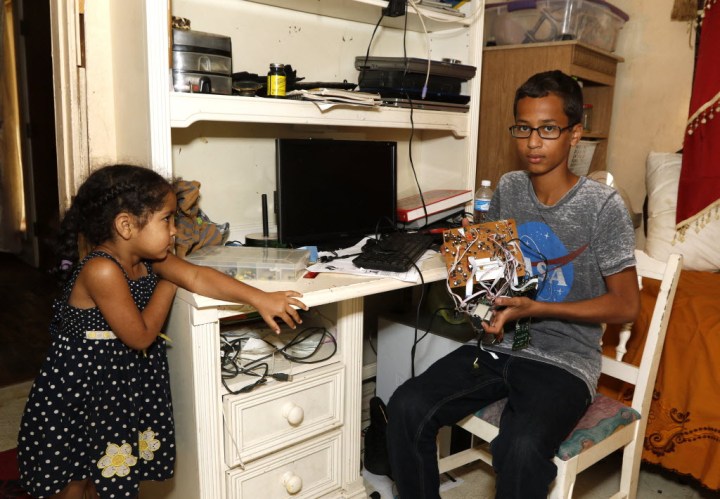
The Dallas Morning News reports that Ahmed, a teenager with an intense interest in radios and robotics who aspires to an engineer, built a digital clock Sunday night and brought it to MacArthur High, the school he attends, on Monday, September 14. Ahmed demonstrated the device – a pencil case containing a simple circuit board, power supply, digital display, and alarm buzzer – to his engineering adviser, who advised him not to show it to other teachers.
Ahmed stowed the clock in his backpack before heading to class, but was forced to show it to his English teacher after it began beeping during a lesson. She confiscated the clock and, believing it to be an explosive, contacted the school administrator, who subsequently notified local law enforcement.
A police officer pulled Ahmed out of sixth period and escorted him to the principal’s office, where he was interrogated and his belongings searched by five law enforcement officials. Ahmed recalled that one officer asked him why he was trying to make “a movie bomb,” and the principal threatened the teenager with suspension if he didn’t make a written statement. “[Ahmed] kept maintaining [the device] was a clock, but there was no explanation,” Irving Police Department spokesman James McLellan later said.
Officers escorted Ahmed from the school in handcuffs, fingerprinted him at a juvenile detention center, and released him to his parents. MacArthur High’s principal, Dan Cummings, suspended Ahmed for three days and documented the incident in a letter to parents on Tuesday. “The Irving County Police Department responded to a suspicious-looking item on campus,” it reads. “The item … did not pose a threat to your child’s safety.”
The clock, McLellan said, “could reasonably be mistaken as a device if left in a bathroom or under a car,” and Police Chief Larry Boyd called it “suspicious in nature” at a press conference Wednesday. The police report cites three MacArthur High teachers as complainants against Ahmed for building a “hoax bomb.”
I expect they will have more to say tomorrow, but Ahmed’s sister asked me to share this photo. A NASA shirt! pic.twitter.com/nR4gt992gB
— Anil Dash (@anildash) September 16, 2015
The North Texas chapter of the Council on American-Islamic Relations is investigating Ahmed’s arrest as ethnically motivated. “This all raises a red flag for us,” Director Alia Salem told The Dallas Morning News. Mohamed Elhassan Mohamed, Ahmed’s father, believes unequivocally that his son was the victim of profiling. “Because his name is Mohamed and because of September 11th, I think [Ahmed] got mistreated,” he told the morning news. Ahmed’s story has generated international headlines and an outpouring of support on social media. On Twitter, the hashtags #IStandWithAhmed and #engineersforahmed have accumulated hundreds of thousands of collective tweets and were trending worldwide as of Wednesday. President Barack Obama tweeted an invitation to the White House’s Astronomy Night, an annual gathering of scientists, engineers, students, and teachers from astronomy and the space industry.
Cool clock, Ahmed. Want to bring it to the White House? We should inspire more kids like you to like science. It’s what makes America great.
— President Obama (@POTUS) September 16, 2015
Presidential hopeful Hillary Clinton followed suit with words of encouragement, as did U.S. Secretary of Education Arne Duncan.
Assumptions and fear don’t keep us safe—they hold us back. Ahmed, stay curious and keep building. https://t.co/ywrlHUw3g1
— Hillary Clinton (@HillaryClinton) September 16, 2015
Facebook chief Mark Zuckerberg urged the teenager to visit the social network’s campus in California. “Ahmed, if you ever want to come by Facebook, I’d love to meet you. Keep building,” he wrote. “Having the skill and ambition to build something cool should lead to applause, not arrest. The future belongs to people like Ahmed.”
In a Facebook post, Irving Mayor Beth Van Duyne defended the actions of MacArthur school officials and the police, but encouraged Ahmed and students like him to “use their creativity, develop innovations, and explore their interests in a manner that fosters higher learning.”
“Hopefully,” she wrote, “we can all learn from this week’s events and the student, who has obvious gifts, will not feel at all discouraged from pursuing his talent in electronics and engineering.”

In a press conference Wednesday afternoon, Irving police announced the teenager would not be charged with possession of a hoax bomb. “The follow-up investigation revealed the device apparently was a homemade experiment, and there’s no evidence to support the perception he intended to create alarm,” said Boyd.
Denying accusations of Islamaphobia, Boyd said the reaction “would have been the same” regardless of the color of the student’s skin. “We live in an age where you can’t take things like that to school … We have to err on the side of caution.”
Ahmed remains suspended from school until Thursday.
At a press conference late Wednesday afternoon, Ahmed addressed a crowd of supporters in a brief appearance. The teenager, who said that he intends to transfer to another school and to take the President up on his offer to visit the White House, told the crowd in attendance that he plans help students in situations similar to his. “Don’t let people change who you are, even if there are consequences for it” he said.


